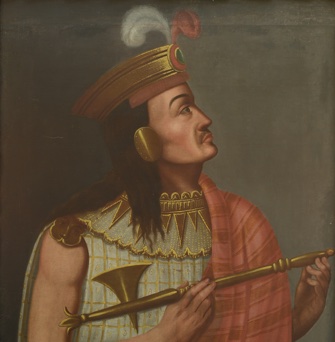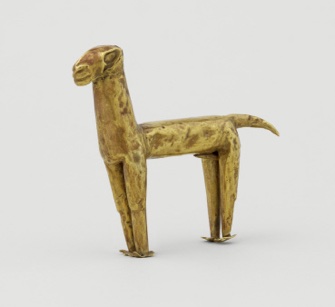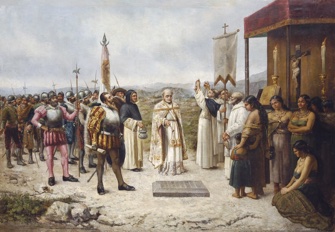Two ‘Great Men’
Battle for Land and Gold

“Portrait of Atahualpa, Inca XIV” (19th century). © Museo Nacional de Arqueología, Antropología e Historia del Perú, Lima
“L’Inca et le Conquistador,” currently showing at the Musée du Quai Branly, chronicles a bloody meeting of worlds. After the success of Columbus’s “discovery” of the West Indies and Cortès’s conquest of the Aztec Empire, opportunist Spaniards crossed the Atlantic to pillage the unparalleled riches of the Inca Empire, the largest in pre-Columbian America. The exhibition has an incredible array of these spoils – an ornate golden llama was a highlight

A llama (1450-1532) made in Trujillo Province of rolls of gold leaf. © Musée du Quai Branly. Photo: Thierry Ollivier, Michel Urtado
for me – as well as beautiful antique maps charting the Americas.
The exhibition focuses on the story of two “great men” pitted against one other in a battle for land and gold. The first, Inca leader Atahualpa, is presented as a fearsome but heroic “god among men”: “Good looking, fairly round, with very fine features, a cruel appearance and bloodshot eyes.”
The second, Francisco Pizarro, the illiterate, low-born conquistador who built his fortune on Incan spoils, is the exhibition’s villain. An intimidating suit of conquistador armor guards the entrance, with a label explaining that weapons, horses and the element of surprise won Peru for the conquistadors, not military prowess.
Pizarro is a fascinating character, mainly thanks to his fluid take on morality. The Spaniards only survived their journey thanks to Incan hospitality: Atahualpa sent food, llamas, weapons and women to the starving invaders to foster friendly relations. In return, the Spaniards brutally attacked their hosts and captured their leader. Having collected a huge

A meeting of two worlds. Painting by José Effio (1879). © Museo Nacional de Arqueología, Antropología e Historia del Perú, Lima
ransom for Atahualpa’s freedom, the Spaniards changed their minds at the 11th hour and had him brutally executed. Before his death, in either a cynical bid to preserve his own line or a gesture of genuine friendship, Atahualpa entrusted his children’s upbringing to Pizarro.
The exhibition sometimes relies too heavily on text instead of letting objects tell their own story, and the introduction of 18th- and 19th-century paintings means its chronology is a little unpredictable. The family tree of the Incans is one such example: painted in the 18th century, when Peru was a republic, the family tree shows the royal bloodline, with the notable exception of Atahualpa, seen by some as an illegitimate usurper – making the Spanish, by extension, pretenders to an empty throne.
The hero-villain narrative of Atahualpa versus Pizarro is immediately absorbing, but the exhibition also takes care to show the uglier side of Incan society. One tunic, belonging to a boy of high social standing pre-conquest, bears a pattern of squares and Greek keys, apparently symbolizing “heads and severed limbs,” as a warning of the fate that would befall anyone who rose up against the Incan authorities, who showed little regard for the indigenous groups under their yoke and maintained a strict social hierarchy.
There is also a note on intermarriage and the messy business of forming a post-colonial society. Pizarro married Atahualpa’s sister, and many Spaniards followed his lead, taking “New World” brides in addition to Spanish ones at home. These marriages made later generations of Peruvians, in the words of Peruvian historian José Antonio del Busto Duthurburu, “neither the captors nor the captured. We are the descendants of both.”
Musée du Quai Branly: 37, quai Branly, 75007 Paris. Métro: Iéna, Alma-Marceau or Bir Hakeim. RER Pont de l’Alma. Tel.: 01 56 61 70 00. Open Tuesday, Wednesday and Sunday 11 a.m.-7 p.m.; Thursday-Saturday, 11 a.m.-9 p.m. Admission: €9. Through September 20. www.quaibranly.fr
Reader reaction: Click here to respond to this article (your response may be published on this page and is subject to editing).
Please support Paris Update by ordering books from Paris Update’s Amazon store at no extra cost. Click on your preferred Amazon location: U.K., France, U.S.
More reviews of Paris art shows.
© 2015 Paris Update
Favorite